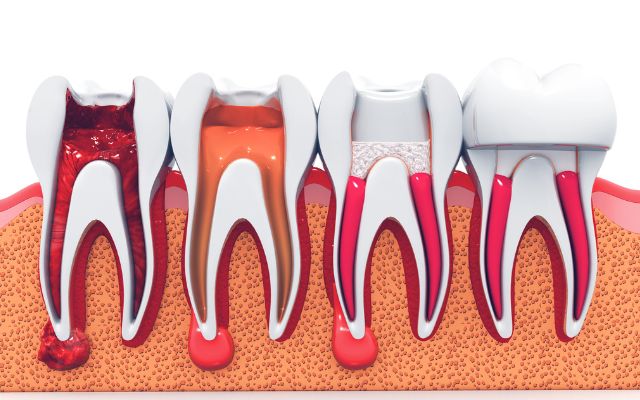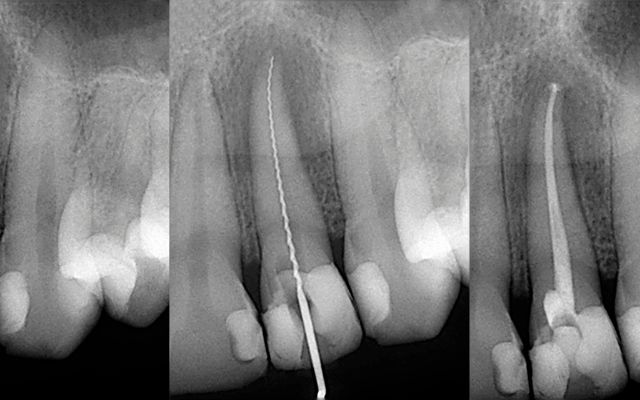Root Canal Treatment
Root Canal Treatment is a procedure in which your dentist or an endodontist cleans and forms the interior of the root canal, removes the infected pulp and nerve in the tooth’s root, and then fills and covers the opening. This page describes root canal therapy in depth, including how it can reduce tooth pain and save your smile.
What Is Root Canal Infection?
Root canal infection is a debilitating oral ailment that can occur when bacteria that already exist in the mouth enter the tooth as a result of untreated dental decay, trauma, or leaking fillings. This can cause the tooth to get infected with bacteria that cause tooth root canal infection.
Root Canal Treatment
Root canal treatment (Endodontic treatment)’s primary goals are to alleviate pain and “rescue” a tooth that has been compromised by infection or decay and cannot be repaired with a filling. Pain usually goes away after the first consultation.
When a tooth’s nerve is compromised by decay or infection, root canal treatment is required. To preserve the tooth, the pulp (the live tissue within the tooth), nerves, germs, and any decay are removed, and the empty area is replaced with specific, medicated dental materials that return the tooth to full function.

Saving a natural tooth is always the best option. Losing a tooth can cause gaps, unattractiveness, and loss of function, and replacing it can be costly. Without root canal therapy, you might lose the affected tooth for good.
The preferred method of saving a tooth that would otherwise need to be extracted is to have a root canal medically performed on it. Many patients believe that removing a problematic tooth is the solution, but what they don’t realize is that extracting (pulling) a tooth will ultimately be more expensive and cause significant problems for neighboring teeth.
Root canal therapy is highly effective and usually lasts a lifetime, though a tooth may need to be retreated on occasion due to new infections.
Benefits Of Root Canal Treatment
Prevents tooth decay
Some individuals prefer tooth extraction to remove the problematic teeth. This is a long-term treatment for preventing future toothaches or dealing with cavities. Patients who get a root canal don’t need to be concerned about tooth loss, which helps to maintain the natural position of your teeth.
Protects neighboring teeth from infection
The primary cause of decay in the tooth cavity is frequently pulp infection. The pulp becomes infected due to the buildup of bacteria in this area. If not treated, the diseased pulp continues to harbor such bacteria, which can readily spread to neighboring teeth.
A root canal is consequently necessary for removing the diseased pulp that harbors germs and so preventing their growth and spread.
Improves the Aesthetics of Teeth
The infected pulp is removed during a root canal procedure. Following that, the afflicted area is cleaned, and the cavity is filled with a polymer substance or a crown is fitted to the tooth.
Crowns are necessary for restoring the aesthetics of teeth. As a result, when employed in a root canal, they assist restore both the functionality and the aesthetic value of the tooth.
Avoids Jawbone Degeneration
In contrast to tooth extraction, a root canal preserves the affected tooth. As a result, this procedure offers an alternative to having the tooth pulled. When teeth are absent, the jawbone degenerates over time owing to bacteria exposure and other factors.
As a result, root canals aid in the prevention of future jawbone issues.
Painless Procedure
A root canal, in contrast to other dental treatments such as root extraction, is a painless and comfortable process. Endodontists remove infected pulp while cleaning and sanitizing the area in a painless procedure.
As a result, it is the favored procedure for dental decay and cavities.
Root Canal Treatment Side Effects
Discoloration of the teeth
Teeth are discolored as nerves are removed. Many patients are unaware of the discolouration. Because a crown is frequently necessary after root canal treatment, this discolouration is not evident in the majority of cases. Bleaching can be used to eliminate discolouration when a dental cap is not required.
Decreased tooth function
The tooth structure gets slightly weaker after root canal treatment. The tooth will no longer function normally. In comparison to other teeth, the risk of breakage is slightly higher. If you have had a root canal treatment on a tooth, you should avoid chewing hard foods such as almonds and instead utilize other teeth. On avoid fracture, always have a dental crown fitted to root canal-treated teeth.
Acute infection
In certain instances, infected teeth that have undergone root canal therapy may also develop infection. The only remedy in the event that the tooth becomes infected after a root canal procedure is extraction.
Inflammation
The root canal must be disinfected and the pulp from the canal chambers removed as part of the root canal treatment. The pulp is filled with nerve endings and is located in the canals in the core of a tooth. The reason for this is because receiving a root canal treatment may cause some discomfort for a few days.
How Do I Know If I Need One?
If a tooth has been badly damaged by decay that has reached the nerve, has an abscess, or is causing severe ongoing pain, chances are it will require root canal treatment.
Signs And Symptoms For Possible Root Canal Therapy:
- An abscess (or pimple) on the gums.
- Sensitivity to hot and cold.
- Severe toothache pain.
- Sometimes no symptoms are present.
- Swelling and/or tenderness.
Reasons For Root Canal Therapy
- Decay has reached the tooth pulp (the living tissue inside the tooth).
- Infection or abscess have developed inside the tooth or at the root tip.
- Injury or trauma to the tooth.
Root Canal Treatment Procedures
Depending on the specific situation, a dentist or endodontist may conduct one or more appointments for a root canal operation.

The root canal procedure is performed in phases (typically three), with sessions spaced several weeks apart. To summarize, the following are the processes involved in a root canal:
After we have described the treatment to you, including the benefits and drawbacks, and obtained your consent, your tooth is anesthetized and isolated:
In order to keep the tooth dry and saliva-free while it is still numb, a rubber dam will be wrapped around it. The procedure begins with the excision of all decayed and damaged nerves. The pulp, nerve tissue, and germs are eliminated one by one using a series of root canal files that are inserted into an access hole formed on top of the tooth. If there is tooth decay, it will be removed with specific dental devices.
After the tooth has been completely cleaned, an antibiotic and analgesic paste will be used to reduce pain and infection. To seal the tooth, a temporary filling is inserted.
Usually one week later, the tooth’s dead tissue is removed, the dental roots’ canals are cleaned and shaped, more antibiotic paste is applied, and a temporary filling is put in place.
Cleaning and sealing of all canals within the tooth roots. Special dental materials will be used to fill and seal the tooth’s roots and interior cavity. To close the hole on top of the tooth, a filling will be put. If more visits are required, a temporary filling may be used until it can be sealed with a permanent filling.
Your tooth may remain sensitive after treatment, but this will fade as the inflammation subsides and the tooth heals.
Following each visit, you will be given care instructions. Regular dental appointments and good oral hygiene practices will extend the life of your root canal therapy.
What Happens After My Root Canal Treatment is Completed?
Most teeth will require a ceramic crown shortly after therapy is done. This is done to guarantee that the tooth does not break or fracture, as the remaining tooth enamel is frequently quite thin and weak after the surgery.
Root Canal Treatment at Spring Orchid Dental
The process of having a root canal has a reputation for being painful. However, thanks to modern procedures, instruments, and anaesthetic, root canal treatment is frequently accomplished with minimal discomfort. Each time you visit our clinic, the Spring Orchid root canal specialists and our entire dental staff make every effort to make your visit is enjoyable and comfortable.
FAQs
Does Root Canal Treatment Hurt?
If a tooth has been badly damaged by decay that has reached the nerve, has an abscess, or is causing severe ongoing pain, chances are it will require root canal treatment.
Signs And Symptoms For Possible Root Canal Therapy:
- An abscess (or pimple) on the gums.
- Sensitivity to hot and cold.
- Severe toothache pain.
- Sometimes no symptoms are present.
- Swelling and/or tenderness.
Reasons For Root Canal Therapy
- Decay has reached the tooth pulp (the living tissue inside the tooth).
- Infection or abscess have developed inside the tooth or at the root tip.
- Injury or trauma to the tooth.
What are The Risks of Root Canal Therapy?
If tooth decay occurs close to the pulp, the pulp may be too weak to produce healthy dentin. If this occurs, a participating dentist or endodontist may need to remove the pulp, or an oral surgeon may need to remove the entire root.
Some dental treatments can allow germs in the mouth to enter the bloodstream and cause illnesses in other regions of the body. Antibiotics may be required before and after dental surgery for those who have problems combating infections.
Individuals who fall within this category include those who:
- Were born with cardiac problems.
- Have either natural or prosthetic heart valves.
- You have liver disease (cirrhosis).
- Have a weakened immune system.
- Have had bacterial endocarditis in the past.
I Really Don't Want a Root Canal Treatment - Are There Any Other Options?
If root canal is not an option for whatever reason, extraction and replacement with a dental implant is often the next best option. Our dentists will guide you through all the pros and cons of each option so you can make an informed decision that you are comfortable and happy with.
While every treatment carries some risk of failures, root canal is usually a very successful treatment. It may last years if completed properly. Some cases are referred to specialists (Periodontists) to achieve the best outcome.
Please consult our professional team for more information on root canal treatments.
Can You Brush Your Teeth After A Root Canal Treatment?
After a dental operation, the dentist will advise you to brush your teeth. You can brush your teeth normally after the numbing medication has worn off.
Can I Work The Next Day After A Root Canal Treatment?
Most individuals can resume their routine activities immediately following their root canal operation. Patients should plan to rest on the day of their root canal operation, and most will be able to return to work the next day.





